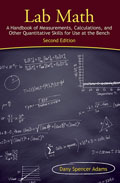(A true story, with some added sarcasm, to illustrate that using equations is safer in the long run than trying to avoid using equations)
My lab has a new centrifuge that I recently needed to use for the first time. Like most centrifuges, you can set the rotations per minute (RPM) and the number of minutes; my protocol said ‘spin at 125 g for 6 minutes.’ Having used many centrifuges, and having written (in Lab Math) about the indefensible* conversion from RPM to g, I expected this. However, when I went to look at the conversion chart that I expected to find taped to the lid of the centrifuge, it wasn’t there. No one had made a spreadsheet to calculate the conversion from g’s to RPMs for frequently used values. No one had measured or looked up the radius of the rotor, or indicated whether it represented the distance to the middle or the tip of the holders. At least, no one had thoughtfully posted it in an obvious place for those who were to follow. So I went in search of someone who I knew had used this centrifuge to find out if this information was kept somewhere that I didn’t know about. The person I found to ask was trained in a lab at Yale. He was told, during his training, that 1.0 RPM (the numbers have been changed to protect the innocent) would give him the correct RCF, and since our centrifuge is about the same size as the one in the Yale lab, he just uses 1.0 RPM. Always.
SERIOUSLY? The equation is: RCF = RPM2 [min-2] x Radius [mm] x 10-6
It is multiplication! Granted, getting out a ruler and measuring from the center of the rotor to the tip of the holder can be physically exhausting and is best left to the young athletic types in your lab. No argument there. But risk your experiments rather than do multiplication? And he learned this at Yale? This is a very smart person, a very good scientist, yet the thought of doing multiplication is so distasteful, that he relies on a number he once heard from someone he considered trustworthy.
What is this ‘culture of equation avoidance’ doing to our scientists? He may someday find himself with a new centrifuge, of a different size, and his 1.0 RPM could lead him to bad data. Troubleshooting will be close to impossible, and he will abandon his beautiful experiment and not get a grant.
Please help him, and scientists like him. Change the culture. Use equations until it hurts.
* I object to the use of “g” as unit for this purpose, although I appreciate that thinking in terms of our constant companion gravity is a comfort. The correct name for the parameter in question is Relative Centrifugal Field or RCF. Without regard for reality, however, RCF is traditionally reported in units of g. RCF has dimensions of length over time squared (L T-2), which is mm/minutes squared in the above equation (rotation is dimensionless). RCF is determined entirely by the rotations per minute and the radius of the rotor. On the other hand, gravitational force has units of, surprise, force, i.e. Newtons, meaning its dimensions are mass x length / time squared (M L T-2). What happens to the mass when you convert to RCF? Traditionally, they’re not telling. So, writing “an RCF of 125 g” is an abomination. However, I have gotten over this and moved on. Really.

Discussion
No comments yet.